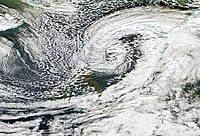 Tilo over the North Sea on 8 November 2007 Tilo over the North Sea on 8 November 2007 Countries affected by the North Sea flood of 2007 Countries affected by the North Sea flood of 2007 | |
| Type | European windstorm, Extratropical |
|---|---|
| Formed | 6 November 2007 |
| Dissipated | 11 November 2007 |
| Lowest pressure | 974 hPa (28.8 inHg) |
| Areas affected | Belgium, Denmark, Germany, Netherlands, Norway and United Kingdom |
Cyclone Tilo (also known as Cyclone Andrea in Norway) was a European windstorm which affected northern and western Europe in early November 2007. Combining with the remnants of Hurricane Noel, Tilo's storm surge led to the North Sea flood of 2007, affecting the coastlines of the Netherlands, the United Kingdom, Germany, Denmark, Norway and Belgium, starting on the night of 8–9 November 2007.
Meteorological history
Cyclone Tilo absorbed the extratropical remnants of ex-Hurricane Noel on 7 November, before rapidly intensifying, which paved the way for the stronger upstream storm Tilo. The jet stream was diverted to the north by a strong ridge of high pressure to the west of Ireland in the Atlantic Ocean, forcing the jet stream over the north of Greenland and back towards Europe. The unusually long fetch was considered important in the potential destructiveness of the storm, stretching down from the Norwegian Sea into the North Sea before reaching the east coast of England and the Dutch and German coasts. In combination with a high tide, the tidal level was expected to exceed 3 metres (9.8 ft) above normal sea levels.
Impact
The flood and waves were expected to overwhelm sea defences and cause extensive flooding; in particular, the coasts of Norfolk and Kent. However, in the event, the storm surge was 20 centimetres (7.9 in) less than forecast, and damage was relatively minor. The water level came to just 10 cm below the top of the sea wall surrounding Great Yarmouth.
Flood warnings were issued for the east coast of Britain and the entire Dutch coast. The Maeslantkering in the port city of Rotterdam was closed for the first time since its construction in 1997. Denmark and Germany issued severe gale warnings for winds gusts up to 125 km/h (78 mph), and the Scottish islands of Orkney and Shetland expected winds gusts up to 145 km/h (90 mph). Oil platforms off the coast of Norway were also closed for the duration of the storm. Felixstowe docks were closed and trains services were suspended between Lowestoft and Norwich due to flooding of the line.
In Scotland all schools in Orkney were closed with some closures also in Caithness and Sutherland. Wind gusts as high as 100 miles per hour (160 km/h) were reported, along with early snow for the Scottish highlands. The Northlink ferry company cancelled sailings between the Northern Isles. Caledonian MacBrayne also cancelled a dozen routes to the Western Isles. 4000 homes lost power in Grampian; there were also reports of trees and roofs being blown down. A rescue tug was called on to stand by a 240-foot (73 m) cargo ship struggling in the sea off Shetland. The A90 road was closed between Aberdeen and Peterhead after a lorry was blown over. A double-decker bus was blown off the road near Mintlaw in Aberdeenshire. There were also reports of a roof blown off in Fraserburgh.
Aftermath
One other consequence of the storm was a record influx of little auks (a small Arctic seabird) into the North Sea, with a count of 18,371 from the Farne Islands on 9 November as they returned north, nearly double the previous record count, then further counts there of 7,143 on 10 November and 28,803 on 11 November.
North Norfolk District Council were left seeking to apply for compensation from the government's Bellwin scheme for natural disasters. Replacing damaged promenade handrails was estimated to cost £20,000, while council-owned beach chalets were estimated to cost more than £40,000 to mend. Inspections were also undertaken of the steel under Cromer pier, where waves had damaged the floor of the Pavilion Theatre.
Gallery
-
 Flooding in Bremerhaven
Flooding in Bremerhaven
-
 Northern dike Bremerhaven
Northern dike Bremerhaven
-
 Weser dike Bremerhaven
Weser dike Bremerhaven
-
 Closed Maeslantkering barrier
Closed Maeslantkering barrier
-
 High water, Hamburg container port
High water, Hamburg container port
-
Flotsam washed up on the sea front at Sheringham, Norfolk, hours after the surge
References
- "Orkantief "Tilo" mit Folgen" (in German). wetteronline.de. Retrieved 25 March 2012.
- "2007 Low pressure names". Free University of Berlin. Archived from the original on 20 April 2012. Retrieved 11 February 2012.
- "Høye bølger setter oljebransjen i beredskap" (in Norwegian). retro.met.no. Archived from the original on 15 July 2012. Retrieved 24 March 2012.
- ^ "Storms of the North Sea". Archived from the original on 9 February 2013. Retrieved 24 March 2012.
- "Surge of 9 November 2007-11-09". National Oceanographic Centre. Archived from the original on 21 February 2012. Retrieved 25 March 2012.
- "North Sea flood tide fears recede". BBC News. 9 November 2007. Retrieved 2007-11-09.
- "Storm surge - November 2007". Met Office. Retrieved 24 March 2012.
- "Threat of English coastal flooding eases". RTÉ News. 9 November 2007. Retrieved 2007-11-09.
- "Thousands go home after tide fear". BBC. 9 November 2007. Retrieved 25 March 2012.
- ^ "100mph Storms Close Roads And Schools". Daily Record. 9 November 2007. Retrieved 25 March 2012.
- "Commuters battle gale force winds". The Scotsman. Retrieved 25 March 2012.
- BirdGuides bird news (requires subscription) Archived 2008-05-17 at the Wayback Machine
- Bird forum archive Retrieved 28 February 2012
- "Surge floods prompt new erosion fears". North Norfolk News. Archived from the original on 24 December 2013. Retrieved 25 March 2012.
External links
- National Oceanography Centre movie model of surge
- Parker and Foden (2009) High-resolution Measurement of a North Sea Storm Surge. Archived 2013-12-24 at the Wayback Machine
- "Storm Surge, Seaham, County Durham": YouTube.